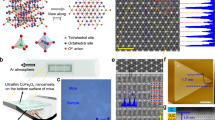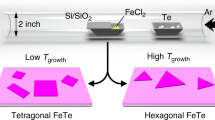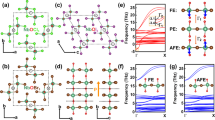Abstract
Arrays of perpendicular ferromagnetic nanowires have recently attracted considerable interest for their potential use in many areas of advanced nanotechnology. We report a simple approach to create self-assembled nanowires of α-Fe through the decomposition of a suitably chosen perovskite. We illustrate the principle behind this approach using the reaction 2La0.5Sr0.5FeO3 → LaSrFeO4 + Fe + O2 that occurs during the deposition of La0.5Sr0.5FeO3 under reducing conditions. This leads to the spontaneous formation of an array of single-crystalline α-Fe nanowires embedded in LaSrFeO4 matrix, which grow perpendicular to the substrate and span the entire film thickness. The diameter and spacing of the nanowires are controlled directly by deposition temperature. The nanowires show uniaxial anisotropy normal to the film plane and magnetization close to that of bulk α-Fe. The high magnetization and sizable coercivity of the nanowires make them desirable for high-density data storage and other magnetic-device applications.
This is a preview of subscription content, access via your institution
Access options
Subscribe to this journal
Receive 12 print issues and online access
$259.00 per year
only $21.58 per issue
Buy this article
- Purchase on Springer Link
- Instant access to full article PDF
Prices may be subject to local taxes which are calculated during checkout





Similar content being viewed by others
References
Shiraki, M., Wakui, Y., Tokushima, T. & Tsuya, N. Perpendicular magnetic media by anodic oxidation method and their recording. IEEE Trans. Magn. 21, 1465–1467 (1985).
Wagner, R.S. & Ellis, W.C. The vapor-liquid-solid mechanism of crystal growth and its application to silicon. Trans. Metal. Soc. AIME 233, 1053–1064 (1965).
Li, F. & Metzger, R.M. Activation volume of α-Fe particles in alumite film. J. Appl. Phys. 81, 3806–3808 (1997).
Huysmans, G.T.A., Lodder, J.C. & Wakui, J. Magnetization curling in perpendicular iron particle arrays (alumite media). J. Appl. Phys. 64, 2016–2021 (1988).
Metzger, R.M. et al. Magnetic nanowires in hexagonally ordered pores of alumina. IEEE Trans. Magn. 36, 30–35 (2000).
Sellmyer, D.J., Zheng, M. & Skomski, R. Magnetism of Fe, Co and Ni, nanowires in self-assembled arrays. J. Phys. Condens. Matter 13, R433–R460 (2001).
Martín, J.I., Nogués, J., Liu, K., Vicente, J.L. & Schuller, I.K. Ordered magnetic nanostructures: fabrication and properties. J. Magn. Magn. Mater. 256, 449–501 (2003).
Chainani, A., Mathew, M. & Sarma, D.D. Electronic structure of La1−xSrxFeO3 . Phys. Rev. B 48, 14818–14825 (1993).
Yang, J.B. et al. Crystal structure, magnetic properties, and Mössbauer studies of La0.6Sr0.4FeO3-δ prepared by quenching in different atmospheres. Phys. Rev. B 66, 184415 (2002).
Chrisey, D.B & Hubler, G.K. (eds) Pulsed Laser Deposition of Thin Films (Wiley, New York, 1994).
Soubeyroux, J.L., Courbin, P., Fournes, P., Fruchart, D. & Le Flem, G. The phase SrLaFeO4: magnetic and crystalline structure. J. Solid State Chem. 31, 313–320 (1980).
Omata, T. et al. Electrical and magnetic properties of hole-doped Sr1+xLa1−xFeO4 . Phys. Rev. B 49, 10194–10199 (1994).
Omata, T. et al. Preparation of oxygen excess SrLaFeO4+δ and its electrical and magnetic properties. Solid State Commun. 88, 807–811 (1993).
Omata, T. et al. Electronic structure of hole-doped Sr1+xLa1−xFeO4 studied by UPS and XAS. Phys. Rev. B 49, 10200–10205 (1994).
Aharony, A., Birgeneau, R.J., Coniglio, A., Kastner, M.A. & Stanley, H.E. Magnetic phase diagram and magnetic pairing in doped La2CuO4 . Phys. Rev. Lett. 60, 1330–1333 (1998).
Cava, R.J. et al. Magnetic and electrical properties of La2−xSrxNiO4±δ . Phys. Rev. B 43, 1229–1232 (1991).
Nagao, M., Tanaka, N. & Mihama, K. High resolution electron microscopy of composite films of gold and magnesium oxide. Jpn J. Appl. Phys. 25, L215–L218 (1986).
Catana, A., Broom, R.F., Bednorz, J.G., Mannhart, J. & Schlom, D.G. Identification of epitaxial Y2O3 inclusions in sputtered YBa2Cu3O7 films: Impact on film growth. Appl. Phys. Lett. 60, 1016–1018 (1992).
Lu, P. et al. High density, ultrafine precipitates in YBa2Cu3O7-x thin films prepared by plasma-enhanced metalorganic chemical vapor deposition. Appl. Phys. Lett. 60, 1265–1267 (1992).
Atzmon, M., Kessler, D.A. & Srolovitz, D.J. Phase separation during film growth. J. Appl. Phys. 72, 442–446 (1992).
Moshnyaga, V. et al. Structural phase transition at the percolation threshold in epitaxial (La0.7Ca0.3MnO3)1−x:(MgO)x nanocomposite films. Nature Mater. 2, 247–252 (2003).
Zheng, H. et al. Multiferroic BaTiO3-CoFe2O4 nanostructures. Science 303, 661–663 (2004).
Bozorth, R.M. Ferromagnetism (IEEE Magnetics Soc., Piscataway, 1993).
Skomski, R., Zeng, H. & Sellmyer, D.J. Magnetic localization in transition-metal nanowires. Phys. Rev. B 62, 3900–3904 (2000).
Vitos, L., Ruban, A.V., Skriver, H.L. & Kollár, J. The surface energy of metals. Surf. Sci. 411, 186–202 (1998).
Spencer, M.J.S., Hung, A., Snook, I.K. & Yarovsky, I. Density functional theory study of the relaxation and energy of iron surfaces. Surf. Sci. 513, 389–398 (2002).
Aldén, M., Skriver, H.L., Mirbt, S. & Johansson, B. Surface energy and magnetism of the 3d metals. Surf. Sci. 315, 157–172 (1994).
Haasen, P. Physical Metallurgy 3rd edn (Cambridge Univ. Press, Cambridge, 1996).
Acknowledgements
This work is supported partly by an ONR MURI grant No. N000140110761, NSF-MRSEC under grant No. DMR-00-80008, and also by the Center for Superconductivity Research at the University of Maryland.
Author information
Authors and Affiliations
Corresponding author
Ethics declarations
Competing interests
The authors declare no competing financial interests.
Supplementary information
Supplementary Information, Fig. S1
Supplementary Information, Fig. S2 (PDF 230 kb)
Rights and permissions
About this article
Cite this article
Mohaddes-Ardabili, L., Zheng, H., Ogale, S. et al. Self-assembled single-crystal ferromagnetic iron nanowires formed by decomposition. Nature Mater 3, 533–538 (2004). https://doi.org/10.1038/nmat1162
Received:
Accepted:
Published:
Issue Date:
DOI: https://doi.org/10.1038/nmat1162
This article is cited by
-
Self-assembling behavior and interface structure in vertically aligned nanocomposite (Pr0.5Ba0.5MnO3)1-x:(CeO2)x films on (001) (La,Sr)(Al,Ta)O3 substrates
Scientific Reports (2020)
-
Creating emergent phenomena in oxide superlattices
Nature Reviews Materials (2019)
-
Effects of Deposition Temperature on the Structural and Physical Properties of Ba(Fe1.8Co0.2)2As2 Thin Film
Journal of Superconductivity and Novel Magnetism (2019)
-
In situ encapsulation of iron(0) for solar thermochemical syngas production over iron-based perovskite material
Communications Chemistry (2018)
-
Photoelectrochemical water splitting enhanced by self-assembled metal nanopillars embedded in an oxide semiconductor photoelectrode
Nature Communications (2016)



